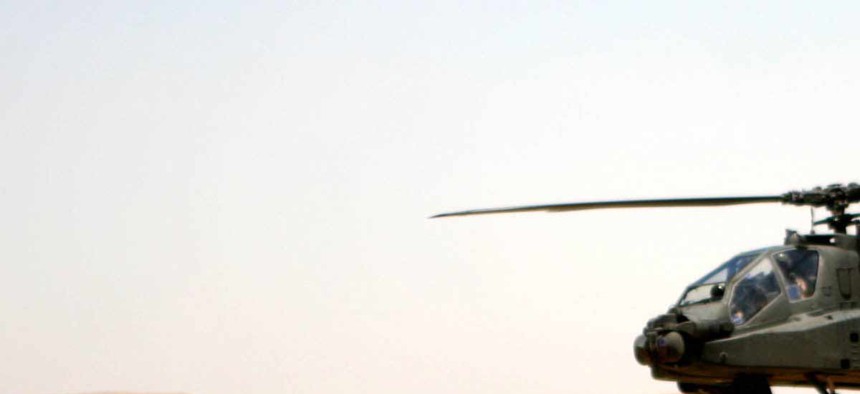
An Apache attack helicopter flies a route between Tall'Afar and Mosul, Iraq, in June 2006. Staff Sgt. Ryan Matson/USA
Army, National Guard Fight Over Apache Helicopters
The plan to give the National Guard’s Apache helicopters to the Army isn’t sitting well with Guard Chief Gen. Frank Grass. By Ben Watson
The Army National Guard is pushing back against a plan to send all of its 192 Apache attack helicopters to the active duty Army. In exchange, the Guard and Reserve components would receive 111 UH-60 Blackhawk transport and utility helicopters from the Army in a broader aviation restructuring after more than a decade of combat and steep budget cuts.
The restructuring would also eliminate three of 13 combat aviation brigades from the Army, while the Guard would phase out its entire fleet of OH-58 Kiowa Warrior scout helicopters, which have been in use for nearly five decades.
This shakeup of Army air assets amounts to some $12 billion in cost-saving measures through fiscal year 2017, Army Chief of Staff Gen. Ray Odierno told members of the Senate Armed Services Committee at a hearing Tuesday.
But National Guard Chief Gen. Frank Grass, who also testified at the hearing, isn’t happy with the plan. “None of us like what we’re having to do,” he said. “My big concern right now is figuring out how I’m going to move, and how many states I’m going to have an impact on, and what’s the cost of facilities and to retrain pilots. I’ve got to tackle that because the decision’s been made.”
The swap is part of a broader question about what the Defense Department sees as the long-term role of the National Guard, after the wars in Iraq and Afghanistan.
(Related: The Battle Between the Air Force and the Air National Guard)
“This is much larger than the Apache discussion,” Grass said. “Especially as we look down the road. It’s brigades. It will affect just about every jurisdiction in the United States when we look at this to get down to the 315,000 number someday that we face.” The “someday number” refers to cuts in Guard personnel, should sequestration continue into FY2016.
Some argue the helicopter swap is needed because the Blackhawk is better suited for natural disaster recovery operations, which Guard units are tasked to do. Sen. Mark Udall, D-Co., said the Blackhawks were instrumental during recent flooding in his state. “In Colorado, we benefited greatly from having National Guard Blackhawks available to perform search and rescue missions, evacuate flood victims, drop water on wildfires, even deliver hay to cattle stranded by blizzards. Have Apaches ever been used for those purposes, and wouldn’t it make sense to have those utility aircraft available to governors for in-state missions?”
“The main mission of those Apaches,” Grass said, “is to be the combat reserve of the Army.”
There are currently nine states where the National Guard flies Apaches.
Rep. Joe Wilson, R-S.C., a member of the House Armed Services Committee, has introduced a bill to block the Apache transfer. “There were times during Operation Iraqi Freedom when the Army National Guard represented 50 percent of the Army’s combat power,” Wilson said in a statement on his website. Both Guard and Reserve troops have accounted for nearly a third of the nation’s more than 2.5 million service members who have deployed to Iraq and Afghanistan since 2001. Nearly 10,000 Guard or Reserve members have deployed more than five times, according to Defense Department data.
Wilson’s bill, which currently has the support of 41 Democrats and 111 Republicans, also calls for a commission to study the proposed changes—a measure Odierno says he sees no need for.
NEXT STORY: The Newfound Political Power of Afghan Youth